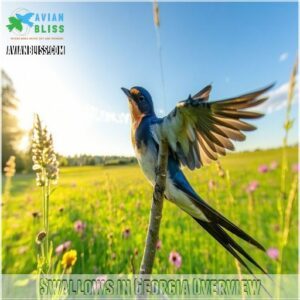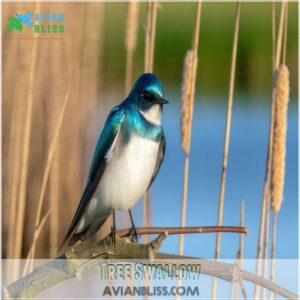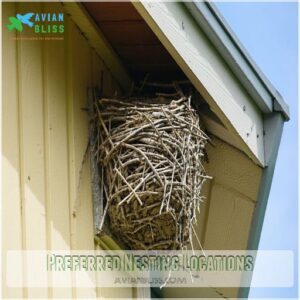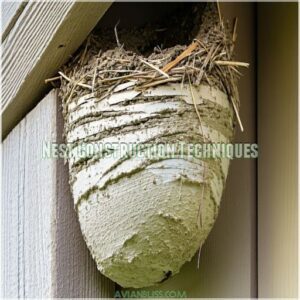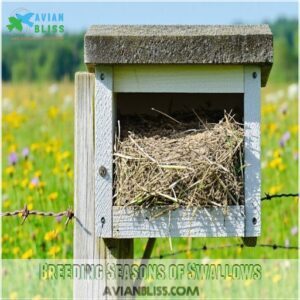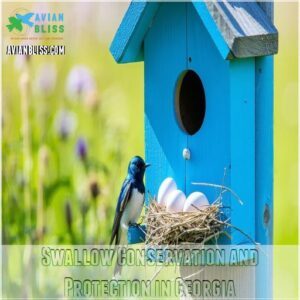This site is supported by our readers. We may earn a commission, at no cost to you, if you purchase through links.
 Swallows in Georgia are a fascinating lot.
Swallows in Georgia are a fascinating lot.
You’ll notice Barn Swallows with their forked tails darting through the sky, while Northern Rough-winged Swallows gracefully sweep over the waters.
These birds are mostly summer residents, with some, like Bank Swallows, stopping by during migration.
They favor open fields, rivers, and even your own backyard for their aerobatic insect hunts.
Ever watched a Tree Swallow’s aerial dance?
Pure poetry in motion.
Interested in learning more about their habitat preferences or the ecological roles they play?
Then you might be curious about the best spots in Georgia for enjoying these sky acrobats.
Table Of Contents
- Key Takeaways
- Swallows in Georgia Overview
- Types of Swallows in Georgia
- Swallow Identification in Georgia
- Swallow Habitats and Nesting Behaviors
- Ecological Value of Swallows in Georgia
- Benefits of Swallows Around Houses
- Preventing Human-Swallow Conflicts
- Swallow Conservation and Protection in Georgia
- Swallow Watching and Tourism in Georgia
- Frequently Asked Questions (FAQs)
- How many types of swallows are there in North America?
- Where can I find tree swallows in North America?
- Where do barn swallows live today?
- What is a tree swallow?
- Do swallows dig their own burrows?
- How do you identify a barn swallow?
- How do swallows impact Georgias agriculture?
- What predators threaten swallows in Georgia?
- Are swallow populations increasing or decreasing in Georgia?
- How do swallows affect other local wildlife?
- What is the diet of Georgia swallows in winter?
- Conclusion
Key Takeaways
- You’ll find Georgia’s swallows incredible natural pest controllers, keeping insects at bay and benefiting local ecosystems.
- Watching them signals a healthy environment; their presence indicates balance in the food web and contributes to ecological health.
- These agile birds arrive in the spring, favoring waterside habitats like lakes, and fields, and are particularly visible during migration.
- Protecting swallows involves understanding their nesting habits and adhering to laws like the Migratory Bird Treaty Act.
Swallows in Georgia Overview
You’ll discover a variety of swallows in Georgia, each with unique physical traits and charming habits. These agile birds arrive in spring and favor habitats like lakes and open fields.
Physical Characteristics of Swallows
When you’re spotting swallows in Georgia, notice a few things.
The swallow wingspan is generally around 12-15 inches, quite impressive for such nimble creatures.
Look at the bill shape—short and flat, perfect for catching insects mid-flight.
Their tail length often hints at species, with some sporting deeply forked tails like those of the Barn Swallows in Georgia summer residents.
Seasonal Presence in Georgia
In Georgia, swallows bring a mix of beauty and purpose.
These migratory birds swoop in with the warmer winds of spring, making their grand entrance in April.
To enhance your experience with these birds, you can find various products related to swallow migration gear.
With the summer breeding season bustling, their songs fill the air until autumn calls them away.
Expect peak swallow sightings until September, when they gracefully depart, leaving behind hints of their nesting season.
Preferred Habitats
As the seasons shift, swallows flock to habitats in Georgia rich with nesting sites and plentiful food sources.
These birds thrive near water—think ponds, lakes, or rivers—providing essential access and shelter.
From barn swallows skimming fields to tree swallows by the marshes, each species carves out its niche.
Their homes mirror Georgia’s diverse landscapes, adapting seamlessly.
Types of Swallows in Georgia
Georgia’s diverse swallow population includes several species, each with unique characteristics.
Barn Swallows are familiar birds, while others like Northern Rough-winged Swallows, Purple Martins, Tree Swallows, and Cliff Swallows are less common.
Each species adds to the state’s avian tapestry.
Barn Swallow
Barn Swallows twirl through Georgia’s skies, adding elegance to your backyard with their deeply forked tails and smooth, iridescent blues. They’re sociable during summer, snagging insects mid-air.
Key Facts:
- Diet: Feasts on insects, making them effective pest controllers.
- Migration: Arrives in Georgia from April to September.
- Song: Cheerful chirps fill the air.
- Folklore: Considered symbols of good luck.
Northern Rough-winged Swallow
So, you’ve got the Northern Rough-winged Swallow fluttering into your birdwatching adventure next.
This species isn’t showy like its barn swallow cousin, flaunting subtle brown hues instead.
Preferring open skies over water, they masterfully snag insects mid-air.
Their nests, tucked into nooks and crannies, highlight their love for secluded spots, playing a key role in natural pest control in Georgia’s ecologies.
Purple Martin
For any birdwatcher growing fond of swallows, the Purple Martin is—well—notably impressive.
Being the largest North American swallow, these birds rely on nesting boxes for breeding, reflecting a fascinating partnership with humans.
Conservation efforts and habitat restoration are essential to support their populations.
Watching them darting gracefully in the sky is a staple of avian enthusiast’s adventures in Georgia.
Tree Swallow
The Purple Martin’s vibrant presence shifts to the graceful Tree Swallow, a common sight during migration in Georgia.
These aerial acrobats flaunt iridescent blue-green plumage, adding sparkle to fields and marshlands.
They feast on insects mid-flight, making their diet an essential part of pest control.
Admire their nests in boxes near water, helping conservation by providing safe havens.
Cliff Swallow
Spotting cliff swallows in Georgia? You’re in for a treat!
These unique birds, boasting stunning rust-red foreheads, favor communal nesting.
Their impressive mud nest building works showcase their intricate colony dynamics.
Watch out for their intraspecific brood parasitism while they navigate their extensive migration routes.
Appreciating these swallow species and understanding the vibrant colors and melodious songs of birds like orioles in texas highlights essential conservation challenges and enriches your bird identification skills.
Swallow Identification in Georgia
When you’re identifying swallows in Georgia, focus on their distinctive visual features such as color patterns and tail shapes.
Observe their flight and vocalization patterns, which vary among species like the Barn Swallow’s acrobatics or the Purple Martin’s melodic calls.
Visual Identification of Swallows
Identifying Georgia’s swallows? It’s easier than you think! Pay close attention to these key features:
- Swallow coloration: Note the bird’s overall color scheme—is it mostly blue, brown, or a mix?
- Wing shapes and tail patterns: Look for long, pointed wings or shorter, rounded ones. Is the tail deeply forked or square?
- Size comparisons: Is it as big as a robin, smaller than a sparrow? Size helps narrow down possibilities. Using a bird identification guide can be helpful.
Flight Patterns of Swallows
When you watch swallows, pay attention to their flight patterns.
They’re a marvel of aerial acrobatics, darting swiftly through the air as they forage for insects, often employing techniques such as thermal soaring tactics.
In Georgia, their wing morphology aids in sharp turns and swift swoops, very important during swallow migration.
Observing swallow flights reveals much about their behavior, from nesting tactics to migration routes.
Vocalization Patterns of Swallows
As swallows dance across the sky, their vocalizations fill the air with a chorus unlike any other.
From cheerful chirps to warning calls, they use vocal mimicry and song variations to communicate.
Here’s a quick breakdown of their chatter:
- Swallow calls signal location.
- Song variations attract mates.
- Vocal mimicry wards off predators.
- Alarm signals warn of danger.
Nesting Habits of Swallows
Swallows, those little architects of the skies, showcase fascinating nesting habits.
They skillfully craft their mud nests, often choosing to build in colonies where they raise their young.
Many prefer reusing old bird nests, adding a hint of nostalgia.
Watch for brood parasitism too—it’s their version of "room-sharing".
These behaviors highlight their resourcefulness and adaptability in Georgia’s diverse habitats.
Swallow Habitats and Nesting Behaviors
When you’re exploring swallow habitats in Georgia, notice how these agile birds choose nesting spots like cliffs, bridges, and eaves of buildings.
Swallow nests, often constructed with mud and lined with grass, provide a secure home for raising their young during the breeding season.
Preferred Nesting Locations
Finding the perfect spot for a cozy nest is something swallows specialize in. They often choose locations like human-made structures or natural cavities, especially near water sources.
- Human-made structures: Bridges, eaves, and nesting boxes.
- Natural cavities: Tree holes and rock crevices.
- Proximity to water: Provides ample insect supply.
- Safe spots: Away from predators for a peaceful home.
Nest Construction Techniques
Bird nests built by swallows are a marvel of mud pellet use and creativity.
These swallow species gather mud, blend it with grass, feathers, and even hair, creating sturdy structures.
You’ll find them under eaves or bridges, showcasing smart material choices and location strategies.
Colony nesting and nest reuse are common, reflecting their resourceful bird behavior.
Breeding Seasons of Swallows
Georgia’s swallow species have varying breeding seasons.
Timing’s everything—nesting begins in spring, often March, extending into September.
Providing swallow-friendly habitats, such as installing Swallow nest boxes, can greatly impact breeding success.
Expect a clutch size of 3-5 eggs per nesting attempt.
Incubation lasts 13-17 days; chicks develop rapidly, fledging in 18-24 days.
Successful breeding hinges on sufficient food and safe nest sites, impacting swallow populations.
For instance, Bank Swallows, as discussed in swallows in Colorado, exhibit versatility in foraging behavior, hunting solo or in groups. Different species exhibit slight variations in these aspects of swallow behavior.
Migratory Patterns of Swallows
Every spring and autumn, you can witness an extraordinary spectacle as swallows journey across Georgia.
Their migration routes align with weather patterns and food availability, creating a synchronized dance in the sky.
Factors affecting migration include weather shifts and food sources, posing challenges they deftly manage.
Research continues to unravel their secrets, enhancing our understanding of these incredible travelers.
Ecological Value of Swallows in Georgia
You mightn’t notice them as they swoop overhead, but swallows in Georgia are industrious insect eaters, helping control pesky populations of flies and mosquitoes.
Their presence often indicates a healthy ecosystem, acting as both predators and prey, maintaining balance in the food web.
Insect Control by Swallows
As summer arrives, swallows swoop through Georgia’s skies, offering natural pest control by feasting on flying insects like flies, mosquitoes, and beetles.
Their agile flight keeps your backyard insect-free, balancing ecosystems without pesticides.
Attracting these birds to your yard can be made easier with the right equipment, such as Swallow feeders online.
Imagine a free pest service just above your head, where swallows dive and feed, highlighting their ecological value and small yet mighty impact on swallow populations.
Swallows as Ecosystem Indicators
Spotting swallows in Georgia is like nature’s way of waving a green flag, showing you the ecosystem’s health.
Their presence often reflects swallow population trends and links to insect diversity.
If you’ve noticed changes in swallow species, it may highlight climate change effects or habitat loss impact.
Observing swallow migration offers clues into their ongoing conservation needs.
Predator-Prey Relationships With Swallows
Swallows in Georgia play a distinct role in local ecosystems, facing both predators like hawks and natural defenses that help them thrive.
You might imagine them gracefully dodging attempts from larger birds, showcasing agile flight as a defense.
Although habitat loss poses a threat, their dynamic behaviors and competitive nature help them persist, contributing to ecological balance and insect control.
Benefits of Swallows Around Houses
You’ll find swallows buzzing around your house more beneficial than you might think, as these agile flyers excel at natural pest control by gobbling up a host of pesky insects.
Creating a swallow-friendly environment helps manage these unwelcome guests and also supports these remarkable birds, enhancing your home’s ecosystem.
Natural Pest Control by Swallows
Georgia’s swallows are amazing insect controllers!
Their swallow diet consists mainly of flying insects—think mosquitoes, flies, and even wasps.
This natural pest control saves you from using harsh chemicals.
Having swallows around means fewer bugs bothering you.
It’s a win-win for you and the environment.
Learn how their presence benefits your yard and the local ecosystem.
Enjoy the show!
Creating Swallow-Friendly Environments
When nurturing swallow-friendly environments, you’re enhancing natural pest control, much like their essential role in Texas ecosystems where they maintain environmental homeostasis by keeping insect populations in check as natural pest control agents.
Encourage swallows by:
- Designing effective nest boxes to attract them.
- Providing swallow food sources such as insects via lush gardens.
- Focusing on habitat restoration and maintaining open spaces.
- Safeguarding nesting sites against urban threats.
Engage your community in creating bird-friendly houses and thriving ecosystems.
Managing Swallow Nests on Buildings
Shifting gears from creating swallow-friendly environments, it’s essential to master managing swallow nests on buildings.
Use gentle tactics for nuisance control while respecting legal issues—active nests need permits for removal.
Consider DIY solutions like installing bird-friendly designs to deter nesting.
Regular cleanup and understanding local wildlife management rules guarantee peaceful coexistence with these aerial acrobats.
Preventing Human-Swallow Conflicts
When swallows decide your porch is their vacation home, you might want to prevent their enthusiastic nest-building habits.
By washing away mud nests frequently and protecting sensitive areas, you can enjoy their aerial acrobatics without the unwanted mess.
Cleaning Up After Swallows
Swallow droppings can be a hassle, but cleaning materials like mild detergent and gloves do wonders.
Nest removal is tricky due to legal protections—empty nests are fair game.
Safety precautions keep you safe from germs.
Preventative measures, like newspaper under nests, help manage messes.
Respect swallow populations for swallow conservation and an enjoyable coexistence with these charming visitors.
Protecting Property From Swallow Nests
Protecting your property from swallow nests requires careful planning.
Several effective strategies exist, minimizing disruption to these protected birds.
Here are three:
- Use physical barriers like mesh or plastic sheeting to prevent nest building on unwanted areas.
- Regularly clean away mud or debris to discourage nest construction.
- Consult local wildlife authorities or professionals for safe and legal nest removal, if absolutely necessary. Remember, many DIY solutions could violate bird protection laws.
Discouraging Swallow Nesting
Move from addressing property concerns to exploring humane swallow deterrent methods.
Consider nesting site modifications, like installing bird-friendly alternatives or using materials such as coroplast to prevent future nests.
Make sure you’re in line with bird protection laws: active swallow nests can’t be tampered with without a permit.
This approach balances preventing human conflicts and respecting nature’s guests.
Swallow Conservation and Protection in Georgia
In Georgia, swallows face threats from habitat loss and climate change, making their conservation critical.
You can support these birds by respecting legal protections, such as the Migratory Bird Treaty Act, which safeguards their nests and populations.
Threats to Swallow Populations
Sometimes, the swallow populations in Georgia face significant threats like habitat loss and pesticide use.
Picture swallows trying to dodge climate change and disease outbreaks, which intensify their troubles.
Nest competition with other bird species also adds to their woes.
The whooping crane’s recovery from a drastically reduced population of only 20 birds in the 1940s to around 600 today, with the help of conservation efforts, including captive breeding programs and wetland management at places like Aransas Wildlife Refuge, reminds us how urgently swallows need safe habitats to thrive and survive.
Legal Protections for Swallows
You’re not alone in worrying about swallows’ survival.
The Migratory Bird Treaty Act has your back—this century-old law shields swallows from harm.
Without proper bird permits, it’s illegal to touch nests with eggs or chicks.
Removing inactive nests is okay, but you’ll need wildlife permits for active ones.
Think of it as nature’s own legal protection.
Conservation Efforts for Swallows
Facing threats from habitat loss and pesticide use, swallows in Georgia need a little help.
Nest box installation and habitat restoration programs boost their populations.
Engaging in citizen science lets you contribute to swallow research and conservation efforts.
Together, these actions create a healthier environment, ensuring swallows continue their important insect control role in Georgian ecosystems.
Swallow Watching and Tourism in Georgia
If you’re seeking a fascinating birdwatching experience, exploring Georgia’s diverse landscapes provides ample opportunities to observe swallows in their natural habitats.
Georgia offers rewarding experiences for both casual observers and dedicated birdwatchers.
Whether you’re following their seasonal migrations or joining a specialized tour.
Best Places to Watch Swallows in Georgia
Protecting Georgia’s swallows is key to their survival.
Want to see these amazing birds? Here are some great spots:
- Coastal marshes: Look for tree swallows near the water.
- Piedmont farmlands: Barn swallows love open fields.
- Okefenokee Swamp: Explore for surprising swallow sightings!
- State parks: Many offer great birdwatching opportunities.
- Wildlife refuges: These protected areas boast diverse swallow colonies.
Swallow Migration Patterns in Georgia
Understanding that various swallow species, such as Barn Swallow and Cliff Swallow, have unique habitat preferences, can be a fascinating journey.
Bank swallows, known for their colonial riverbank habitats, are found on every continent except Australia and Antarctica. Swallow species set out on these incredible migrations, guided by innate routes that crisscross Georgia’s skies.
Timing is everything, as they dodge threats during migration, including severe weather and predators.
Research and conservation efforts are pivotal in ensuring these bird populations thrive, shedding light on bird migration intricacies across the state.
Swallow Watching Tours and Events
Explore swallow watching in Georgia, where guided tours offer unforgettable encounters with these agile fliers.
Observations of their mud nest constructions, similar to those of the Barn Swallow’s comma-shaped mud nests(Barn Swallow Nesting Habits), are a highlight of the experience.
Here’s what to expect:
- Swallow sightings: Connect with nature’s acrobats.
- Photography opportunities: Capture their graceful flight.
- Best times to visit: Spring and fall migrations.
- Local guides: Knowledgeable birding experts.
- Conservation efforts: Learn about protecting their habitats.
Frequently Asked Questions (FAQs)
How many types of swallows are there in North America?
Swallows, like the Barn Swallow, which migrates to South America for winter, imagine a dance in the sky: North America boasts eight swallow species, each with unique flair.
From the barn swallow to the purple martin, these aerial acrobats help keep insect populations in check.
They also enchant watchers below.
Where can I find tree swallows in North America?
You can spot tree swallows across North America, particularly around lakes, marshes, and ponds during migration.
They’re often drawn to areas with nesting boxes.
Look for their iridescent greenish-blue feathers and buff white underparts.
Where do barn swallows live today?
Barn swallows are found across North America, except for the far north.
They’re summer visitors in many areas, migrating south for the winter.
You’ll often spot them near farms and open fields.
What is a tree swallow?
A tree swallow is a small bird with glossy greenish-blue feathers and white bellies, known for its swift flight and insect-catching skills.
It nests near water and readily occupies nesting boxes in backyards.
Do swallows dig their own burrows?
Swallows generally don’t dig their own burrows.
Instead, they use mud to build nests on cliffs, buildings, or other structures.
Bank swallows do nest in burrows, preferring sandy banks they can excavate.
How do you identify a barn swallow?
To spot a barn swallow, look for its deep blue back and reddish-orange throat.
Its distinctive forked tail and agile, darting flight make it a standout while it gracefully snatches insects mid-air.
How do swallows impact Georgias agriculture?
In Georgia, swallows munch on pesky insects like beetles and moths, naturally curbing pest populations.
This eco-friendly pest control saves farmers money on pesticides, boosting crop health and yields while promoting a balanced agricultural ecosystem.
What predators threaten swallows in Georgia?
As you observe these agile birds, several predators threaten their existence, including domestic cats, snakes, weasels, raccoons, and birds of prey like hawks, owls, and falcons.
All these predators are competing for survival in their ecosystem.
Are swallow populations increasing or decreasing in Georgia?
Ironically, precise swallow population trends in Georgia are elusive. Ongoing research is needed to determine whether numbers are rising or falling. More data is needed for definitive answers.
How do swallows affect other local wildlife?
Swallows act like skilled pest controllers, consuming vast numbers of insects, benefiting local ecosystems by reducing pest populations.
Their presence supports a balanced food web, indirectly aiding plants and animals reliant on lower insect numbers.
What is the diet of Georgia swallows in winter?
Winter’s chill means swallows migrate south, so their Georgia diet isn’t relevant.
Instead, they feast on flying insects in warmer climates like the tropics, where abundant food keeps them happily fluttering and fueling their journeys.
Conclusion
Picture a Georgia sunset where swallows perform breathtaking aerial ballets, capturing insects in graceful swoops.
Swallows in Georgia aren’t just beautiful; they play key ecological roles, efficiently controlling pests and indicating environmental health.
Their diverse habitats—from rivers to urban areas—offer endless watching spots throughout the state.
When observing these fascinating birds, remember their contribution to nature’s balance and the importance of conservation efforts.
Get closer to Georgia’s skies and embrace the magic of witnessing swallows firsthand.

